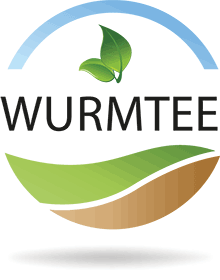Wie Wurmhumus Schädlinge unterdrückt:
Pflanzen die mit anorganischen Düngemitteln angebaut sind, sind anfälliger für Schädlingsbefall als die Pflanzen, die mit organischem Dünger gedüngt werden:
- Culliney TW, Pimentel D (1986) Ecological effects of organic agricultural practices on insect populations. Agric Ecosyst Environ 15:253-256
- Yardim EN, Edwards CA (2003) Effects of organic and synthetic fertilizer sources on pest and predatory insects associated with tomatoes. Phytoparasitica 31:324-329
- Phelan PL (2004) Connecting below-ground and above-ground food webs: the role of organic matter in biological buffering. In: Magadoff F, Well RR (eds) Soil Organic Matter in sustainable agriculture, CRC Press, Boca Raton. pp 199-226
Anorganische Stickstoffdüngung verbessert die Schmackhaftigkeit der Wirtspflanzen für Schädlinge und hemmt die Produktion der sekundären Stoffwechselprodukte (Metaboliten):
- Fragoyiannis DA, McKinlay RG, D’Mello JPF (2001) Interactions of aphids herbivory and nitrogen availability on the total foliar glycoalkoloid content of potato plants. J Chem Ecol 27:1749-1762
- Herms DA (2002) Effects of fertilization on insect resistance of woody ornamental plants. Environ Entomol 31:923-933
Die Anwendung von anorganischem Dünger zieht mehr Insekten zur Eiablage an und erhöht ihre Fruchtbarkeit und Bevölkerungswachstumsraten::
- Bentz JA, Reeves J, Barbosa P, Francis B (1995) Nitrogen fertilizer effect on selection, acceptance and suitability of Euphorbia pulcherrima (Euphorbiaceae) as a host plant to Bemisia tabaci (Homoptera: Aleyrodidae). Environ Entomol 24:40-45
- Culliney TW, Pimentel D (1986) Ecological effects of organic agricultural practices on insect populations. Agric Ecosyst Environ 15:253-256
- Jannsson RK, Smilowitz Z (1986) Influence of nitrogen on population parameters of potato insects: abundance, population growth and within-plant distribution of the green peach aphid, Myzus persicae (Homoptera: Aphididae). Environ Entomol 15:49-55
Wurmkompost als organischer Dünger hat ein langsames, ausgewogenes Nahrungsfreisetzungsmuster vor allem in Freisetzung von Verfügbarem N, löslichem K, austauschbarem Ca, Mg und P. Die Pflanzen haben einen verringerten Stickstoffgehalt und höheren Phenolgehalt, was zum Widerstand dieser Pflanzen gegen Schädlingsbefall führt:
- Patriquin DG, Baines D, Abboud A (1995) Diseases, pests and soil fertility. In: Cook HF, Lee HC (eds) Soil Management in Sustainable Agriculture, Wye College Press, Wye. pp 161-174
- Steffen KL, Dan MS, Harper JK, Fleischer SJ, Mkhize SS, Grenoble DW, MacNab AA, Fager K (1995) Evaluation of the initial season for implementation of four tomato production systems. J Am Soc Hort Sci 120:148-156
- Asami DK, Hang YJ, Barnett DM, Mitchell AE (2003) Comparison of the total phenolic and ascorbic acid content of freeze-dried and air-dried marionberry, strawberry and corn grown using conventional organic and sustainable agricultural practices. J Agric Food Chem 51:1237-1241
- Edwards CA, Fletcher KE (1988) Interaction between earthworms and microorganisms in organic matter breakdown. Agric Ecosyst Environ 20:235-249
- Edwards CA (1998) The use of earthworms in the breakdown and management of organic wastes. In: Edwards CA (ed) Earthworm Ecology, CRC Press, Boca Raton. pp 327-354
Wurmhumus ist reich an Huminsäuren und Phenolverbindungen. Die Aufnahme von löslichen phenolischen Verbindungen von Wurmkompostin in den Pflanzengeweben macht sie für Schädlinge ungenießbar und verringert die Fortpflanzung und das Überleben von Schädlingen:
- Kurowska A, Gora J, Kalemba D (1990) Effects of plant phenols on insects. Pol Wiad Chem 44:399-409
- Summers G, Felton GW (1994) Prooxidation effects of phenolic acids on the generalist herbivore Helicoverpa zea: potential mode of action of phenolic compounds on plant anti-herbivory chemistry. Insect Biochem Mol Biol 24:943-953
- QiTian S (2004) Research on prevention and elimination of agricultural pests by ginkgo phenols phenolic acids. Chem Ind For Prod 24:83
- Hawida S, Kapari L, Ossipov V, Ramtala MJ, Ruuhola T, Haukioja E (2007) Foliar phenolics are differently associated with Epirrita autmnata growth and immuno competence. J Chem Ecol 33:1013-1023
- Koul O (2008) Phytochemicals and insect control: an antifeedant approach. Crit Rev Plant Sci 27:1-24
- Mahanil S, Attajarusit J, Stout MJ, Thipayong P (2008) Over expression of tomato phenol oxidase increases resistance to the common cutworm. Plant Sci 174:456-466
- Bhonwong A, Stout MJ, Attajarusit J, Tantasawat P (2009) Defensive role of tomato polyphenoloxidases against cotton bollworm (Helicoverpa armigera) and beet army worm (Spodoptera exigua). J Chem Ecol 35:28-38
- Knuutinen J, Palm H, Hakala H, Haimi J, Huhta V, Salminen J (1990) Polychlorinated phenols and their metabolites in soil and earthworms of a saw mill environment. Chemosphere 20:609-623
- Park SR, Cho EJ, Yu KH, Kim YS, Suh JJ, Chang CS (1996) Endogenous phenoloxidase from an earthworm Lumbricus rubellus. Tongmul Hakoehi 39:36-46
- Vinken R, Schaeffer A, Ji R (2005) Abiotic association of soil-borne monomeric phenols with humic acids. Org Geochem 36:583-593
- Edwards CA, Arancon NQ, Bennett MV, Askar A, Keeney G, Little B (2010) Suppression of green peach aphid (Myzus persicae) (Sulz.), citrus mealybug (Planococcus citri) (Risso), and two spotted spider mite (Tetranychus urticae) (Koch.) attacks on tomatoes and cucumbers by aqueous extracts from vermicomposts. Crop Prot 29:80-93
- Edwards CA, Arancon NQ, Bennett MV, Askar A, Keeney G (2010) Effect of aqueous extracts from vermicomposts on attacks by cucumber beetles (Acalymna vittatum) (Fabr.) on cucumbers and tobacco hornworm (Manduca sexta) (L.) on tomatoes. Pedobiologia 53:141-148


